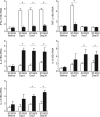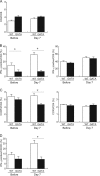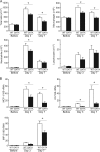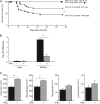Impairment of host defense against disseminated candidiasis in mice overexpressing GATA-3
- PMID: 20231412
- PMCID: PMC2863530
- DOI: 10.1128/IAI.01398-09
Impairment of host defense against disseminated candidiasis in mice overexpressing GATA-3
Abstract
Candida species are the most common source of nosocomial invasive fungal infections. Previous studies have indicated that T-helper immune response is the critical host factor for susceptibility to Candida infection. The transcription factor GATA-3 is known as the master regulator for T-helper type 2 (Th2) differentiation. We therefore investigated the role of GATA-3 in the host defense against systemic Candida infection using GATA-3-overexpressing transgenic mice. The survival of GATA-3-overexpressing mice after Candida infection was significantly lower than that of wild-type mice. Candida outgrowth was significantly increased in the kidneys of GATA-3-overexpressing mice, compared with wild-type mice. The levels of various Th2 cytokines, including interleukin-4 (IL-4), IL-5, and IL-13, were significantly higher while the level of Th1 cytokine gamma interferon was significantly lower in the splenocytes of GATA-3-overexpressing mice after Candida infection. Recruitment of macrophages into the peritoneal cavity in response to Candida infection and their phagocytic activity were significantly lower in GATA-3-overexpressing mice than in wild-type mice. Exogenous administration of gamma interferon to GATA-3-overexpressing mice significantly reduced Candida outgrowth in the kidney and thus increased the survival rate. Administration of gamma interferon also increased the recruitment of macrophages into the peritoneal cavity in response to Candida infection. These results indicate that overexpression of GATA-3 modulates macrophage antifungal activity and thus enhances the susceptibility to systemic Candida infection, possibly by reducing the production of gamma interferon in response to Candida infection.
Figures







Similar articles
-
Overexpression of the transcription factor GATA-3 enhances the development of pulmonary fibrosis.Am J Pathol. 2006 Jul;169(1):96-104. doi: 10.2353/ajpath.2006.051160. Am J Pathol. 2006. PMID: 16816364 Free PMC article.
-
Overexpression of GATA-3 protects against the development of hypersensitivity pneumonitis.Am J Respir Crit Care Med. 2007 Nov 15;176(10):1015-25. doi: 10.1164/rccm.200612-1887OC. Epub 2007 Aug 23. Am J Respir Crit Care Med. 2007. PMID: 17717199
-
Role of TLR1 and TLR6 in the host defense against disseminated candidiasis.FEMS Immunol Med Microbiol. 2008 Jan;52(1):118-23. doi: 10.1111/j.1574-695X.2007.00353.x. Epub 2007 Nov 22. FEMS Immunol Med Microbiol. 2008. PMID: 18036178
-
[iNKT cells participate in the exacerbation of systemic candidal infection].Med Mycol J. 2014;55(3):J115-22. doi: 10.3314/mmj.55.j115. Med Mycol J. 2014. PMID: 25231226 Review. Japanese.
-
Cytokines in candidiasis and aspergillosis.Curr Pharm Biotechnol. 2000 Nov;1(3):235-51. doi: 10.2174/1389201003378924. Curr Pharm Biotechnol. 2000. PMID: 11469382 Review.
Cited by
-
The Role of B-Cells and Antibodies against Candida Vaccine Antigens in Invasive Candidiasis.Vaccines (Basel). 2021 Oct 10;9(10):1159. doi: 10.3390/vaccines9101159. Vaccines (Basel). 2021. PMID: 34696267 Free PMC article. Review.
-
Overexpression of T-bet, GATA-3 and TGF-ß Induces IFN-γ, IL-4/13A, and IL-17A Expression in Atlantic Salmon.Biology (Basel). 2020 Apr 20;9(4):82. doi: 10.3390/biology9040082. Biology (Basel). 2020. PMID: 32326041 Free PMC article.
-
Candida albicans and Candida glabrata: global priority pathogens.Microbiol Mol Biol Rev. 2024 Jun 27;88(2):e0002123. doi: 10.1128/mmbr.00021-23. Epub 2024 Jun 4. Microbiol Mol Biol Rev. 2024. PMID: 38832801 Free PMC article. Review.
-
T-cell Subsets and Antifungal Host Defenses.Curr Fungal Infect Rep. 2010 Dec;4(4):238-243. doi: 10.1007/s12281-010-0034-6. Epub 2010 Sep 30. Curr Fungal Infect Rep. 2010. PMID: 20976286 Free PMC article.
-
Antibodies to Pseudogymnoascus destructans are not sufficient for protection against white-nose syndrome.Ecol Evol. 2015 Jun;5(11):2203-14. doi: 10.1002/ece3.1502. Epub 2015 May 11. Ecol Evol. 2015. PMID: 26078857 Free PMC article.
References
-
- Abbas, A. K., K. M. Murphy, and A. Sher. 1996. Functional diversity of helper T lymphocytes. Nature 383:787-793. - PubMed
-
- Antachopoulos, C., T. J. Walsh, and E. Roilides. 2007. Fungal infection in primary immunodeficiencies. Eur. J. Pediatr. 166:1099-1117. - PubMed
-
- Ashman, R. B., C. S. Farah, S. Wanasaengsakul, Y. Hu, G. Pang, and R. L. Clancy. 2004. Innate versus adaptive immunity in Candida albicans infection. Immunol. Cell Biol. 82:196-204. - PubMed
-
- Cenci, E., A. Mencacci, G. Del Sero, C. Fe d'Ostiani, P. Mosci, M. Kopf, and L. Romani. 1998. IFN-γ is required for IL-12 responsiveness in mice with Candida albicans infection. J. Immunol. 161:3543-3550. - PubMed
Publication types
MeSH terms
Substances
LinkOut - more resources
Full Text Sources
Medical
Molecular Biology Databases

